Jaguars of the Pantanal, 2009
Trip Report
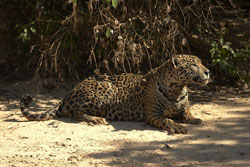
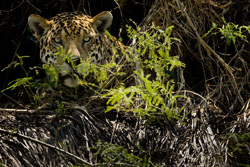
Check out our Wildlife Portfolio of this trip, our Jaguar Portfolio,
and our two Participants Portfolios -
the Wildlife and Landscapes and the Birds.
Our 2010 Brochure is now available
It is amazing how an image, a brief encounter or even a glimpse, can burn itself into one's memory. My brain has been branded in this way, as, on the first full day in jaguar country, we spotted a large male jaguar resting upon a steep river bank above us. A huge and shattered tree trunk and a pair of skinny palm-like plants framed the cat on its right, while the cat, paws extended forward in a calm position of repose, faced forward. Whether or not that view would have been 'the best shot' we'd obtain over the next several days is doubtful, there were too many contenders for that, but that vision could have taken my breath away had I not been too busy trying to play out the anchor line to help our boatman get ourselves set for our shooting. By the time we set anchor, less than a minute in total, and I turned back to the cat it was gone. I sighed, shook my head, and shrugged, about to beat myself up for not just shooting with an unsecured, floating boat. But I didn't have time.
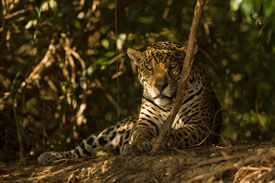 We drifted downstream, and quickly located the jaguar again. Over the next six hours we were with the cat almost constantly. The photography was phenomenal, starting with the jaguar reemerging along the river bank where it sat and watched us, only its forequarters visible as we fired away. It moved on, lying in the deep shade of a small clearing where, as we drifted by, we had several wonderful chances for frame-filling shots. The cat disappeared, and we thought we lost it, but the jaguar swam across the river and, as we headed up river, we had our best shooting yet. Incredibly, the jaguar stalked along the shallows, stalked an iguana and a cabybara, made an unsuccessful rush but the cabybara, the world's largest rodent, an antelope-like beaver on steroids, dove into the brown river and was gone.
We drifted downstream, and quickly located the jaguar again. Over the next six hours we were with the cat almost constantly. The photography was phenomenal, starting with the jaguar reemerging along the river bank where it sat and watched us, only its forequarters visible as we fired away. It moved on, lying in the deep shade of a small clearing where, as we drifted by, we had several wonderful chances for frame-filling shots. The cat disappeared, and we thought we lost it, but the jaguar swam across the river and, as we headed up river, we had our best shooting yet. Incredibly, the jaguar stalked along the shallows, stalked an iguana and a cabybara, made an unsuccessful rush but the cabybara, the world's largest rodent, an antelope-like beaver on steroids, dove into the brown river and was gone.
On several occasions the jaguar strutted across open sand bars, sometimes lying down along the bank so close that the cat would not fit within our camera frame with a 500mm lens. Incredibly, using a 28-300 provided the best compositions, the cat was so close! Eventually the jaguar settled down and seemed set, and our group, sated, headed back to our base camp for lunch.
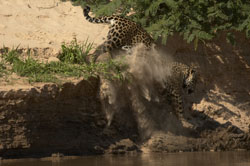
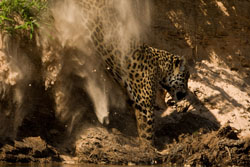
This wasn't our first jaguar, we had had that same cat the evening previous as we boated in to our jaguar camp for our first evening. That was an auspicious start, and reflected the luck we enjoyed throughout our stay, for we had a jaguar sighting and the potential of photography on six of our eight attempts. I say 'potential' because we quickly grew quite picky, as, for example, when we returned in the afternoon that day to find the cat in the same location, offering nothing new as we moved on.
Leaving a jaguar might seem ridiculous, but the Pantanal has so much to offer that we were lured by our other subjects. On our second full day in jaguar country it appeared that our previous day's luck had deserted us, but towards noon we discovered another jaguar. My boat was the first to arrive, and as we quietly poled towards the cat, perched on the river bank and close, it got up and moved, and again I worried that our shooting opportunity was lost. It wasn't.
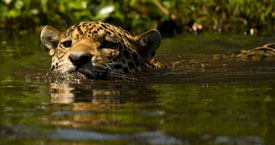 Instead, the jaguar began to work the shoreline, sometimes walking down to the river's edge, or traveling along the higher bank, offering quick glimpses and fleeting shooting opportunities. We followed along, trying to keep up or get ahead, and eventually the jaguar moved into a small bay. The cat settled there for a few minutes but then moved off, and we thought the jaguar show was done. Instead, however, the cat doubled back, and as we watched with amazement the jaguar walked down to the water, pushing through the shoreline vegetation and pushing itself into the open water. Two of our three boats were so close, and directly in the cat's path, that they had to scramble and pole backwards to give this oblivious feline a clear path as it swam across the narrow bay. We couldn't believe our luck, photographing the jaguar at virtually frame-filling head shots as it swam, SWAM, right by us!
Instead, the jaguar began to work the shoreline, sometimes walking down to the river's edge, or traveling along the higher bank, offering quick glimpses and fleeting shooting opportunities. We followed along, trying to keep up or get ahead, and eventually the jaguar moved into a small bay. The cat settled there for a few minutes but then moved off, and we thought the jaguar show was done. Instead, however, the cat doubled back, and as we watched with amazement the jaguar walked down to the water, pushing through the shoreline vegetation and pushing itself into the open water. Two of our three boats were so close, and directly in the cat's path, that they had to scramble and pole backwards to give this oblivious feline a clear path as it swam across the narrow bay. We couldn't believe our luck, photographing the jaguar at virtually frame-filling head shots as it swam, SWAM, right by us!
The show wasn't over. Later, the cat snuggled itself through a brushy thicket to emerge in a narrow hollow, offering wonderful full-frame shots of a cat now hunting. Backing out from this ambush site the jaguar moved to an opening where it settled down, watching us confidently before giving us a clear-view yawn, and finally moving off deep into the forest. It was now 1PM, and lunch time, something we hadn't thought or cared about, but now ... why not.
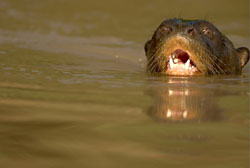
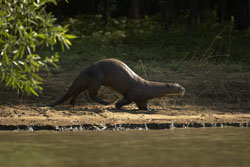
On our third full day we decided to try for something different, and headed up another river system to a lodge that hosted a very healthy population of hyacinth macaws, the largest parrot of the Pantanal, and where giant otters were frequently seen. As we headed upriver to our destination, just minutes after starting, we were called back, as one of our boats spotted another jaguar swimming across the river. My boat and one of our other's arrived just as the cat reached the shoreline, and we watched it swim along, then clamber out and walk the shoreline for several minutes before wandering off into the heavy brush.
We headed upriver, and as we hoped we had luck with the macaws and giant otters, following one group of otters as they captured a catfish and zig-zagged through the shoreline vegetation, offering fleeting, tantalizing chances for shots.
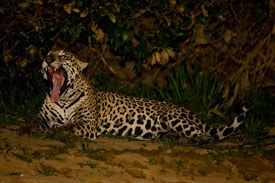 That afternoon, on another cruise, we spotted another group of otters, and this time the show was lengthy and rewarding. We had found an otter den and, spotting a head deep in the shadows of the burrow, we decided to wait. Less than an half hour later three otters emerged, slipping down the slick ramp they'd worn into the clay river bank, and heading up stream. A fourth, and perhaps a fifth otter remained behind, and we waited, hoping these would emerge as well. They eventually did, but only after the first three otters returned from the trip upriver, and captured another catfish species. This that ate noisily nearby, and afterwards the otters approached our boats, whistling, chattering, and screaming in their distinctive, bold vocalizations, and we stayed with them to nearly dark and until they returned to their burrow. As we headed back to camp we encountered another jaguar, lying upon the river bank in full view. It was almost dark and I mounted my flash and set my ISO to 1250, and, surprisingly, obtained some great shots.
That afternoon, on another cruise, we spotted another group of otters, and this time the show was lengthy and rewarding. We had found an otter den and, spotting a head deep in the shadows of the burrow, we decided to wait. Less than an half hour later three otters emerged, slipping down the slick ramp they'd worn into the clay river bank, and heading up stream. A fourth, and perhaps a fifth otter remained behind, and we waited, hoping these would emerge as well. They eventually did, but only after the first three otters returned from the trip upriver, and captured another catfish species. This that ate noisily nearby, and afterwards the otters approached our boats, whistling, chattering, and screaming in their distinctive, bold vocalizations, and we stayed with them to nearly dark and until they returned to their burrow. As we headed back to camp we encountered another jaguar, lying upon the river bank in full view. It was almost dark and I mounted my flash and set my ISO to 1250, and, surprisingly, obtained some great shots.
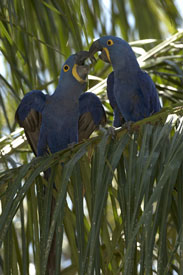
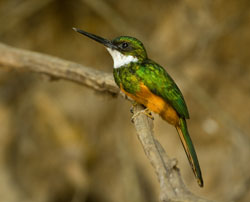
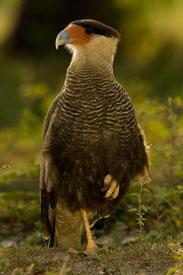
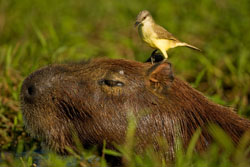 Of course, there was much more to this shoot than just jaguars. I spotted an ocelot on our first morning, walking a boardwalk in the pre-dawn gloom, and giving me some worry as I hoped my size perception was correct, and the cat that I was watching was indeed ocelot, and not jaguar, size. We photographed one Brazilian tapir, South America's largest mammal, as it lay along a deeply shaded river bank.
Of course, there was much more to this shoot than just jaguars. I spotted an ocelot on our first morning, walking a boardwalk in the pre-dawn gloom, and giving me some worry as I hoped my size perception was correct, and the cat that I was watching was indeed ocelot, and not jaguar, size. We photographed one Brazilian tapir, South America's largest mammal, as it lay along a deeply shaded river bank.
I set up a trail camera and photographed an agouti, a common but furtive forest-dwelling rodent that resembles an African dik-dik antelope more than its cousin the rat, and, because I procrastinated, I missed photographing another jaguar with my game camera as it walked back and forth on a trail at our last destination, where we expected to simply film birds.
The bird photography was incredible, and for us it is the ace in the hole, for even if we had not had luck with jaguars our shoot would have been successful because of the birds. One of our participants told me that he hoped to get 10 great shots of birds, but the shots he made (see Participants Portfolio-Birds) far exceeded 10. In fact, he got shots of some species of birds that I've only had glimpses of, birds like the furtive sungrebe, a beautiful, heavily neck-striped waterbird that resembles a yellow loon, and numerous others. It proved, so clearly, that if a photographer had an interest in a subject, and paid attention to every opportunity, the chances of getting great shots were there. I was awed, and a bit humbled, by that bird portfolio!
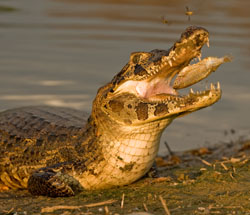
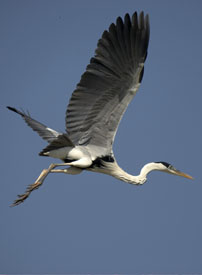 In all, we probably photographed over 40 different species of birds, including herons, egrets, storks, parrots, raptors, and various perching birds. Some of our highlights had to include the jabiru stork nest, which we photographed from above nest height, various kingfishers at frame-filling distance or as they dove into the water to fish, and black-collared hawks, greater black hawks, and yellow-headed caracaras fishing and snatching prey just yards from our boats.
In all, we probably photographed over 40 different species of birds, including herons, egrets, storks, parrots, raptors, and various perching birds. Some of our highlights had to include the jabiru stork nest, which we photographed from above nest height, various kingfishers at frame-filling distance or as they dove into the water to fish, and black-collared hawks, greater black hawks, and yellow-headed caracaras fishing and snatching prey just yards from our boats.
Mary and I both shot over 100 gigs of material, and are now in the process of culling down that body of work to 20 gigs or so of outstanding keepers. Check out our Portfolio of some of our favorite images. Those images will have to sustain us for the next year, until we return to the Pantanal again next year to hopefully enjoy even better luck.
A final word, to recap, has to recognize the great work of our guide, Fisher, and the boatmen that operated our crafts, getting us into wonderful positions and often spotting game we'd otherwise have missed. The food was great, the lodging fine, and the Brazilian hospitality first class. I'd urge anyone reading this to join us on our next adventure here.
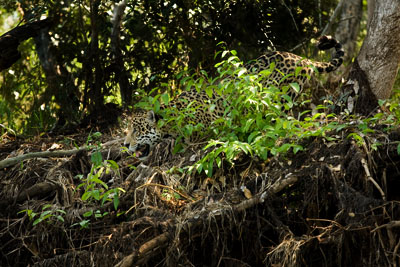
Check out our Participants Bird Portfolio,
our Participants Wildlife Portfolio,
and Joe and Mary Ann's Personal Portfolio.
Jaguars of the Pantanal, 2009
Trip Report


Check out our Wildlife Portfolio of this trip, our Jaguar Portfolio,
and our two Participants Portfolios -
the Wildlife and Landscapes and the Birds.
Our 2010 Brochure is now available
It is amazing how an image, a brief encounter or even a glimpse, can burn itself into one's memory. My brain has been branded in this way, as, on the first full day in jaguar country, we spotted a large male jaguar resting upon a steep river bank above us. A huge and shattered tree trunk and a pair of skinny palm-like plants framed the cat on its right, while the cat, paws extended forward in a calm position of repose, faced forward. Whether or not that view would have been 'the best shot' we'd obtain over the next several days is doubtful, there were too many contenders for that, but that vision could have taken my breath away had I not been too busy trying to play out the anchor line to help our boatman get ourselves set for our shooting. By the time we set anchor, less than a minute in total, and I turned back to the cat it was gone. I sighed, shook my head, and shrugged, about to beat myself up for not just shooting with an unsecured, floating boat. But I didn't have time.
 We drifted downstream, and quickly located the jaguar again. Over the next six hours we were with the cat almost constantly. The photography was phenomenal, starting with the jaguar reemerging along the river bank where it sat and watched us, only its forequarters visible as we fired away. It moved on, lying in the deep shade of a small clearing where, as we drifted by, we had several wonderful chances for frame-filling shots. The cat disappeared, and we thought we lost it, but the jaguar swam across the river and, as we headed up river, we had our best shooting yet. Incredibly, the jaguar stalked along the shallows, stalked an iguana and a cabybara, made an unsuccessful rush but the cabybara, the world's largest rodent, an antelope-like beaver on steroids, dove into the brown river and was gone.
We drifted downstream, and quickly located the jaguar again. Over the next six hours we were with the cat almost constantly. The photography was phenomenal, starting with the jaguar reemerging along the river bank where it sat and watched us, only its forequarters visible as we fired away. It moved on, lying in the deep shade of a small clearing where, as we drifted by, we had several wonderful chances for frame-filling shots. The cat disappeared, and we thought we lost it, but the jaguar swam across the river and, as we headed up river, we had our best shooting yet. Incredibly, the jaguar stalked along the shallows, stalked an iguana and a cabybara, made an unsuccessful rush but the cabybara, the world's largest rodent, an antelope-like beaver on steroids, dove into the brown river and was gone.
On several occasions the jaguar strutted across open sand bars, sometimes lying down along the bank so close that the cat would not fit within our camera frame with a 500mm lens. Incredibly, using a 28-300 provided the best compositions, the cat was so close! Eventually the jaguar settled down and seemed set, and our group, sated, headed back to our base camp for lunch.


This wasn't our first jaguar, we had had that same cat the evening previous as we boated in to our jaguar camp for our first evening. That was an auspicious start, and reflected the luck we enjoyed throughout our stay, for we had a jaguar sighting and the potential of photography on six of our eight attempts. I say 'potential' because we quickly grew quite picky, as, for example, when we returned in the afternoon that day to find the cat in the same location, offering nothing new as we moved on.
Leaving a jaguar might seem ridiculous, but the Pantanal has so much to offer that we were lured by our other subjects. On our second full day in jaguar country it appeared that our previous day's luck had deserted us, but towards noon we discovered another jaguar. My boat was the first to arrive, and as we quietly poled towards the cat, perched on the river bank and close, it got up and moved, and again I worried that our shooting opportunity was lost. It wasn't.
 Instead, the jaguar began to work the shoreline, sometimes walking down to the river's edge, or traveling along the higher bank, offering quick glimpses and fleeting shooting opportunities. We followed along, trying to keep up or get ahead, and eventually the jaguar moved into a small bay. The cat settled there for a few minutes but then moved off, and we thought the jaguar show was done. Instead, however, the cat doubled back, and as we watched with amazement the jaguar walked down to the water, pushing through the shoreline vegetation and pushing itself into the open water. Two of our three boats were so close, and directly in the cat's path, that they had to scramble and pole backwards to give this oblivious feline a clear path as it swam across the narrow bay. We couldn't believe our luck, photographing the jaguar at virtually frame-filling head shots as it swam, SWAM, right by us!
Instead, the jaguar began to work the shoreline, sometimes walking down to the river's edge, or traveling along the higher bank, offering quick glimpses and fleeting shooting opportunities. We followed along, trying to keep up or get ahead, and eventually the jaguar moved into a small bay. The cat settled there for a few minutes but then moved off, and we thought the jaguar show was done. Instead, however, the cat doubled back, and as we watched with amazement the jaguar walked down to the water, pushing through the shoreline vegetation and pushing itself into the open water. Two of our three boats were so close, and directly in the cat's path, that they had to scramble and pole backwards to give this oblivious feline a clear path as it swam across the narrow bay. We couldn't believe our luck, photographing the jaguar at virtually frame-filling head shots as it swam, SWAM, right by us!
The show wasn't over. Later, the cat snuggled itself through a brushy thicket to emerge in a narrow hollow, offering wonderful full-frame shots of a cat now hunting. Backing out from this ambush site the jaguar moved to an opening where it settled down, watching us confidently before giving us a clear-view yawn, and finally moving off deep into the forest. It was now 1PM, and lunch time, something we hadn't thought or cared about, but now ... why not.


On our third full day we decided to try for something different, and headed up another river system to a lodge that hosted a very healthy population of hyacinth macaws, the largest parrot of the Pantanal, and where giant otters were frequently seen. As we headed upriver to our destination, just minutes after starting, we were called back, as one of our boats spotted another jaguar swimming across the river. My boat and one of our other's arrived just as the cat reached the shoreline, and we watched it swim along, then clamber out and walk the shoreline for several minutes before wandering off into the heavy brush.
We headed upriver, and as we hoped we had luck with the macaws and giant otters, following one group of otters as they captured a catfish and zig-zagged through the shoreline vegetation, offering fleeting, tantalizing chances for shots.
 That afternoon, on another cruise, we spotted another group of otters, and this time the show was lengthy and rewarding. We had found an otter den and, spotting a head deep in the shadows of the burrow, we decided to wait. Less than an half hour later three otters emerged, slipping down the slick ramp they'd worn into the clay river bank, and heading up stream. A fourth, and perhaps a fifth otter remained behind, and we waited, hoping these would emerge as well. They eventually did, but only after the first three otters returned from the trip upriver, and captured another catfish species. This that ate noisily nearby, and afterwards the otters approached our boats, whistling, chattering, and screaming in their distinctive, bold vocalizations, and we stayed with them to nearly dark and until they returned to their burrow. As we headed back to camp we encountered another jaguar, lying upon the river bank in full view. It was almost dark and I mounted my flash and set my ISO to 1250, and, surprisingly, obtained some great shots.
That afternoon, on another cruise, we spotted another group of otters, and this time the show was lengthy and rewarding. We had found an otter den and, spotting a head deep in the shadows of the burrow, we decided to wait. Less than an half hour later three otters emerged, slipping down the slick ramp they'd worn into the clay river bank, and heading up stream. A fourth, and perhaps a fifth otter remained behind, and we waited, hoping these would emerge as well. They eventually did, but only after the first three otters returned from the trip upriver, and captured another catfish species. This that ate noisily nearby, and afterwards the otters approached our boats, whistling, chattering, and screaming in their distinctive, bold vocalizations, and we stayed with them to nearly dark and until they returned to their burrow. As we headed back to camp we encountered another jaguar, lying upon the river bank in full view. It was almost dark and I mounted my flash and set my ISO to 1250, and, surprisingly, obtained some great shots.



 Of course, there was much more to this shoot than just jaguars. I spotted an ocelot on our first morning, walking a boardwalk in the pre-dawn gloom, and giving me some worry as I hoped my size perception was correct, and the cat that I was watching was indeed ocelot, and not jaguar, size. We photographed one Brazilian tapir, South America's largest mammal, as it lay along a deeply shaded river bank.
Of course, there was much more to this shoot than just jaguars. I spotted an ocelot on our first morning, walking a boardwalk in the pre-dawn gloom, and giving me some worry as I hoped my size perception was correct, and the cat that I was watching was indeed ocelot, and not jaguar, size. We photographed one Brazilian tapir, South America's largest mammal, as it lay along a deeply shaded river bank.
I set up a trail camera and photographed an agouti, a common but furtive forest-dwelling rodent that resembles an African dik-dik antelope more than its cousin the rat, and, because I procrastinated, I missed photographing another jaguar with my game camera as it walked back and forth on a trail at our last destination, where we expected to simply film birds.
The bird photography was incredible, and for us it is the ace in the hole, for even if we had not had luck with jaguars our shoot would have been successful because of the birds. One of our participants told me that he hoped to get 10 great shots of birds, but the shots he made (see Participants Portfolio-Birds) far exceeded 10. In fact, he got shots of some species of birds that I've only had glimpses of, birds like the furtive sungrebe, a beautiful, heavily neck-striped waterbird that resembles a yellow loon, and numerous others. It proved, so clearly, that if a photographer had an interest in a subject, and paid attention to every opportunity, the chances of getting great shots were there. I was awed, and a bit humbled, by that bird portfolio!

 In all, we probably photographed over 40 different species of birds, including herons, egrets, storks, parrots, raptors, and various perching birds. Some of our highlights had to include the jabiru stork nest, which we photographed from above nest height, various kingfishers at frame-filling distance or as they dove into the water to fish, and black-collared hawks, greater black hawks, and yellow-headed caracaras fishing and snatching prey just yards from our boats.
In all, we probably photographed over 40 different species of birds, including herons, egrets, storks, parrots, raptors, and various perching birds. Some of our highlights had to include the jabiru stork nest, which we photographed from above nest height, various kingfishers at frame-filling distance or as they dove into the water to fish, and black-collared hawks, greater black hawks, and yellow-headed caracaras fishing and snatching prey just yards from our boats.
Mary and I both shot over 100 gigs of material, and are now in the process of culling down that body of work to 20 gigs or so of outstanding keepers. Check out our Portfolio of some of our favorite images. Those images will have to sustain us for the next year, until we return to the Pantanal again next year to hopefully enjoy even better luck.
A final word, to recap, has to recognize the great work of our guide, Fisher, and the boatmen that operated our crafts, getting us into wonderful positions and often spotting game we'd otherwise have missed. The food was great, the lodging fine, and the Brazilian hospitality first class. I'd urge anyone reading this to join us on our next adventure here.

Check out our Participants Bird Portfolio,
our Participants Wildlife Portfolio,
and Joe and Mary Ann's Personal Portfolio.
Jaguars of the Pantanal, 2009
Trip Report


Check out our Wildlife Portfolio of this trip, our Jaguar Portfolio,
and our two Participants Portfolios -
the Wildlife and Landscapes and the Birds.
Our 2010 Brochure is now available
It is amazing how an image, a brief encounter or even a glimpse, can burn itself into one's memory. My brain has been branded in this way, as, on the first full day in jaguar country, we spotted a large male jaguar resting upon a steep river bank above us. A huge and shattered tree trunk and a pair of skinny palm-like plants framed the cat on its right, while the cat, paws extended forward in a calm position of repose, faced forward. Whether or not that view would have been 'the best shot' we'd obtain over the next several days is doubtful, there were too many contenders for that, but that vision could have taken my breath away had I not been too busy trying to play out the anchor line to help our boatman get ourselves set for our shooting. By the time we set anchor, less than a minute in total, and I turned back to the cat it was gone. I sighed, shook my head, and shrugged, about to beat myself up for not just shooting with an unsecured, floating boat. But I didn't have time.
 We drifted downstream, and quickly located the jaguar again. Over the next six hours we were with the cat almost constantly. The photography was phenomenal, starting with the jaguar reemerging along the river bank where it sat and watched us, only its forequarters visible as we fired away. It moved on, lying in the deep shade of a small clearing where, as we drifted by, we had several wonderful chances for frame-filling shots. The cat disappeared, and we thought we lost it, but the jaguar swam across the river and, as we headed up river, we had our best shooting yet. Incredibly, the jaguar stalked along the shallows, stalked an iguana and a cabybara, made an unsuccessful rush but the cabybara, the world's largest rodent, an antelope-like beaver on steroids, dove into the brown river and was gone.
We drifted downstream, and quickly located the jaguar again. Over the next six hours we were with the cat almost constantly. The photography was phenomenal, starting with the jaguar reemerging along the river bank where it sat and watched us, only its forequarters visible as we fired away. It moved on, lying in the deep shade of a small clearing where, as we drifted by, we had several wonderful chances for frame-filling shots. The cat disappeared, and we thought we lost it, but the jaguar swam across the river and, as we headed up river, we had our best shooting yet. Incredibly, the jaguar stalked along the shallows, stalked an iguana and a cabybara, made an unsuccessful rush but the cabybara, the world's largest rodent, an antelope-like beaver on steroids, dove into the brown river and was gone.
On several occasions the jaguar strutted across open sand bars, sometimes lying down along the bank so close that the cat would not fit within our camera frame with a 500mm lens. Incredibly, using a 28-300 provided the best compositions, the cat was so close! Eventually the jaguar settled down and seemed set, and our group, sated, headed back to our base camp for lunch.


This wasn't our first jaguar, we had had that same cat the evening previous as we boated in to our jaguar camp for our first evening. That was an auspicious start, and reflected the luck we enjoyed throughout our stay, for we had a jaguar sighting and the potential of photography on six of our eight attempts. I say 'potential' because we quickly grew quite picky, as, for example, when we returned in the afternoon that day to find the cat in the same location, offering nothing new as we moved on.
Leaving a jaguar might seem ridiculous, but the Pantanal has so much to offer that we were lured by our other subjects. On our second full day in jaguar country it appeared that our previous day's luck had deserted us, but towards noon we discovered another jaguar. My boat was the first to arrive, and as we quietly poled towards the cat, perched on the river bank and close, it got up and moved, and again I worried that our shooting opportunity was lost. It wasn't.
 Instead, the jaguar began to work the shoreline, sometimes walking down to the river's edge, or traveling along the higher bank, offering quick glimpses and fleeting shooting opportunities. We followed along, trying to keep up or get ahead, and eventually the jaguar moved into a small bay. The cat settled there for a few minutes but then moved off, and we thought the jaguar show was done. Instead, however, the cat doubled back, and as we watched with amazement the jaguar walked down to the water, pushing through the shoreline vegetation and pushing itself into the open water. Two of our three boats were so close, and directly in the cat's path, that they had to scramble and pole backwards to give this oblivious feline a clear path as it swam across the narrow bay. We couldn't believe our luck, photographing the jaguar at virtually frame-filling head shots as it swam, SWAM, right by us!
Instead, the jaguar began to work the shoreline, sometimes walking down to the river's edge, or traveling along the higher bank, offering quick glimpses and fleeting shooting opportunities. We followed along, trying to keep up or get ahead, and eventually the jaguar moved into a small bay. The cat settled there for a few minutes but then moved off, and we thought the jaguar show was done. Instead, however, the cat doubled back, and as we watched with amazement the jaguar walked down to the water, pushing through the shoreline vegetation and pushing itself into the open water. Two of our three boats were so close, and directly in the cat's path, that they had to scramble and pole backwards to give this oblivious feline a clear path as it swam across the narrow bay. We couldn't believe our luck, photographing the jaguar at virtually frame-filling head shots as it swam, SWAM, right by us!
The show wasn't over. Later, the cat snuggled itself through a brushy thicket to emerge in a narrow hollow, offering wonderful full-frame shots of a cat now hunting. Backing out from this ambush site the jaguar moved to an opening where it settled down, watching us confidently before giving us a clear-view yawn, and finally moving off deep into the forest. It was now 1PM, and lunch time, something we hadn't thought or cared about, but now ... why not.


On our third full day we decided to try for something different, and headed up another river system to a lodge that hosted a very healthy population of hyacinth macaws, the largest parrot of the Pantanal, and where giant otters were frequently seen. As we headed upriver to our destination, just minutes after starting, we were called back, as one of our boats spotted another jaguar swimming across the river. My boat and one of our other's arrived just as the cat reached the shoreline, and we watched it swim along, then clamber out and walk the shoreline for several minutes before wandering off into the heavy brush.
We headed upriver, and as we hoped we had luck with the macaws and giant otters, following one group of otters as they captured a catfish and zig-zagged through the shoreline vegetation, offering fleeting, tantalizing chances for shots.
 That afternoon, on another cruise, we spotted another group of otters, and this time the show was lengthy and rewarding. We had found an otter den and, spotting a head deep in the shadows of the burrow, we decided to wait. Less than an half hour later three otters emerged, slipping down the slick ramp they'd worn into the clay river bank, and heading up stream. A fourth, and perhaps a fifth otter remained behind, and we waited, hoping these would emerge as well. They eventually did, but only after the first three otters returned from the trip upriver, and captured another catfish species. This that ate noisily nearby, and afterwards the otters approached our boats, whistling, chattering, and screaming in their distinctive, bold vocalizations, and we stayed with them to nearly dark and until they returned to their burrow. As we headed back to camp we encountered another jaguar, lying upon the river bank in full view. It was almost dark and I mounted my flash and set my ISO to 1250, and, surprisingly, obtained some great shots.
That afternoon, on another cruise, we spotted another group of otters, and this time the show was lengthy and rewarding. We had found an otter den and, spotting a head deep in the shadows of the burrow, we decided to wait. Less than an half hour later three otters emerged, slipping down the slick ramp they'd worn into the clay river bank, and heading up stream. A fourth, and perhaps a fifth otter remained behind, and we waited, hoping these would emerge as well. They eventually did, but only after the first three otters returned from the trip upriver, and captured another catfish species. This that ate noisily nearby, and afterwards the otters approached our boats, whistling, chattering, and screaming in their distinctive, bold vocalizations, and we stayed with them to nearly dark and until they returned to their burrow. As we headed back to camp we encountered another jaguar, lying upon the river bank in full view. It was almost dark and I mounted my flash and set my ISO to 1250, and, surprisingly, obtained some great shots.



 Of course, there was much more to this shoot than just jaguars. I spotted an ocelot on our first morning, walking a boardwalk in the pre-dawn gloom, and giving me some worry as I hoped my size perception was correct, and the cat that I was watching was indeed ocelot, and not jaguar, size. We photographed one Brazilian tapir, South America's largest mammal, as it lay along a deeply shaded river bank.
Of course, there was much more to this shoot than just jaguars. I spotted an ocelot on our first morning, walking a boardwalk in the pre-dawn gloom, and giving me some worry as I hoped my size perception was correct, and the cat that I was watching was indeed ocelot, and not jaguar, size. We photographed one Brazilian tapir, South America's largest mammal, as it lay along a deeply shaded river bank.
I set up a trail camera and photographed an agouti, a common but furtive forest-dwelling rodent that resembles an African dik-dik antelope more than its cousin the rat, and, because I procrastinated, I missed photographing another jaguar with my game camera as it walked back and forth on a trail at our last destination, where we expected to simply film birds.
The bird photography was incredible, and for us it is the ace in the hole, for even if we had not had luck with jaguars our shoot would have been successful because of the birds. One of our participants told me that he hoped to get 10 great shots of birds, but the shots he made (see Participants Portfolio-Birds) far exceeded 10. In fact, he got shots of some species of birds that I've only had glimpses of, birds like the furtive sungrebe, a beautiful, heavily neck-striped waterbird that resembles a yellow loon, and numerous others. It proved, so clearly, that if a photographer had an interest in a subject, and paid attention to every opportunity, the chances of getting great shots were there. I was awed, and a bit humbled, by that bird portfolio!

 In all, we probably photographed over 40 different species of birds, including herons, egrets, storks, parrots, raptors, and various perching birds. Some of our highlights had to include the jabiru stork nest, which we photographed from above nest height, various kingfishers at frame-filling distance or as they dove into the water to fish, and black-collared hawks, greater black hawks, and yellow-headed caracaras fishing and snatching prey just yards from our boats.
In all, we probably photographed over 40 different species of birds, including herons, egrets, storks, parrots, raptors, and various perching birds. Some of our highlights had to include the jabiru stork nest, which we photographed from above nest height, various kingfishers at frame-filling distance or as they dove into the water to fish, and black-collared hawks, greater black hawks, and yellow-headed caracaras fishing and snatching prey just yards from our boats.
Mary and I both shot over 100 gigs of material, and are now in the process of culling down that body of work to 20 gigs or so of outstanding keepers. Check out our Portfolio of some of our favorite images. Those images will have to sustain us for the next year, until we return to the Pantanal again next year to hopefully enjoy even better luck.
A final word, to recap, has to recognize the great work of our guide, Fisher, and the boatmen that operated our crafts, getting us into wonderful positions and often spotting game we'd otherwise have missed. The food was great, the lodging fine, and the Brazilian hospitality first class. I'd urge anyone reading this to join us on our next adventure here.

Check out our Participants Bird Portfolio,
our Participants Wildlife Portfolio,
and Joe and Mary Ann's Personal Portfolio.
Jaguars of the Pantanal, 2009
Trip Report


Check out our Wildlife Portfolio of this trip, our Jaguar Portfolio,
and our two Participants Portfolios -
the Wildlife and Landscapes and the Birds.
Our 2010 Brochure is now available
It is amazing how an image, a brief encounter or even a glimpse, can burn itself into one's memory. My brain has been branded in this way, as, on the first full day in jaguar country, we spotted a large male jaguar resting upon a steep river bank above us. A huge and shattered tree trunk and a pair of skinny palm-like plants framed the cat on its right, while the cat, paws extended forward in a calm position of repose, faced forward. Whether or not that view would have been 'the best shot' we'd obtain over the next several days is doubtful, there were too many contenders for that, but that vision could have taken my breath away had I not been too busy trying to play out the anchor line to help our boatman get ourselves set for our shooting. By the time we set anchor, less than a minute in total, and I turned back to the cat it was gone. I sighed, shook my head, and shrugged, about to beat myself up for not just shooting with an unsecured, floating boat. But I didn't have time.
 We drifted downstream, and quickly located the jaguar again. Over the next six hours we were with the cat almost constantly. The photography was phenomenal, starting with the jaguar reemerging along the river bank where it sat and watched us, only its forequarters visible as we fired away. It moved on, lying in the deep shade of a small clearing where, as we drifted by, we had several wonderful chances for frame-filling shots. The cat disappeared, and we thought we lost it, but the jaguar swam across the river and, as we headed up river, we had our best shooting yet. Incredibly, the jaguar stalked along the shallows, stalked an iguana and a cabybara, made an unsuccessful rush but the cabybara, the world's largest rodent, an antelope-like beaver on steroids, dove into the brown river and was gone.
We drifted downstream, and quickly located the jaguar again. Over the next six hours we were with the cat almost constantly. The photography was phenomenal, starting with the jaguar reemerging along the river bank where it sat and watched us, only its forequarters visible as we fired away. It moved on, lying in the deep shade of a small clearing where, as we drifted by, we had several wonderful chances for frame-filling shots. The cat disappeared, and we thought we lost it, but the jaguar swam across the river and, as we headed up river, we had our best shooting yet. Incredibly, the jaguar stalked along the shallows, stalked an iguana and a cabybara, made an unsuccessful rush but the cabybara, the world's largest rodent, an antelope-like beaver on steroids, dove into the brown river and was gone.
On several occasions the jaguar strutted across open sand bars, sometimes lying down along the bank so close that the cat would not fit within our camera frame with a 500mm lens. Incredibly, using a 28-300 provided the best compositions, the cat was so close! Eventually the jaguar settled down and seemed set, and our group, sated, headed back to our base camp for lunch.


This wasn't our first jaguar, we had had that same cat the evening previous as we boated in to our jaguar camp for our first evening. That was an auspicious start, and reflected the luck we enjoyed throughout our stay, for we had a jaguar sighting and the potential of photography on six of our eight attempts. I say 'potential' because we quickly grew quite picky, as, for example, when we returned in the afternoon that day to find the cat in the same location, offering nothing new as we moved on.
Leaving a jaguar might seem ridiculous, but the Pantanal has so much to offer that we were lured by our other subjects. On our second full day in jaguar country it appeared that our previous day's luck had deserted us, but towards noon we discovered another jaguar. My boat was the first to arrive, and as we quietly poled towards the cat, perched on the river bank and close, it got up and moved, and again I worried that our shooting opportunity was lost. It wasn't.
 Instead, the jaguar began to work the shoreline, sometimes walking down to the river's edge, or traveling along the higher bank, offering quick glimpses and fleeting shooting opportunities. We followed along, trying to keep up or get ahead, and eventually the jaguar moved into a small bay. The cat settled there for a few minutes but then moved off, and we thought the jaguar show was done. Instead, however, the cat doubled back, and as we watched with amazement the jaguar walked down to the water, pushing through the shoreline vegetation and pushing itself into the open water. Two of our three boats were so close, and directly in the cat's path, that they had to scramble and pole backwards to give this oblivious feline a clear path as it swam across the narrow bay. We couldn't believe our luck, photographing the jaguar at virtually frame-filling head shots as it swam, SWAM, right by us!
Instead, the jaguar began to work the shoreline, sometimes walking down to the river's edge, or traveling along the higher bank, offering quick glimpses and fleeting shooting opportunities. We followed along, trying to keep up or get ahead, and eventually the jaguar moved into a small bay. The cat settled there for a few minutes but then moved off, and we thought the jaguar show was done. Instead, however, the cat doubled back, and as we watched with amazement the jaguar walked down to the water, pushing through the shoreline vegetation and pushing itself into the open water. Two of our three boats were so close, and directly in the cat's path, that they had to scramble and pole backwards to give this oblivious feline a clear path as it swam across the narrow bay. We couldn't believe our luck, photographing the jaguar at virtually frame-filling head shots as it swam, SWAM, right by us!
The show wasn't over. Later, the cat snuggled itself through a brushy thicket to emerge in a narrow hollow, offering wonderful full-frame shots of a cat now hunting. Backing out from this ambush site the jaguar moved to an opening where it settled down, watching us confidently before giving us a clear-view yawn, and finally moving off deep into the forest. It was now 1PM, and lunch time, something we hadn't thought or cared about, but now ... why not.


On our third full day we decided to try for something different, and headed up another river system to a lodge that hosted a very healthy population of hyacinth macaws, the largest parrot of the Pantanal, and where giant otters were frequently seen. As we headed upriver to our destination, just minutes after starting, we were called back, as one of our boats spotted another jaguar swimming across the river. My boat and one of our other's arrived just as the cat reached the shoreline, and we watched it swim along, then clamber out and walk the shoreline for several minutes before wandering off into the heavy brush.
We headed upriver, and as we hoped we had luck with the macaws and giant otters, following one group of otters as they captured a catfish and zig-zagged through the shoreline vegetation, offering fleeting, tantalizing chances for shots.
 That afternoon, on another cruise, we spotted another group of otters, and this time the show was lengthy and rewarding. We had found an otter den and, spotting a head deep in the shadows of the burrow, we decided to wait. Less than an half hour later three otters emerged, slipping down the slick ramp they'd worn into the clay river bank, and heading up stream. A fourth, and perhaps a fifth otter remained behind, and we waited, hoping these would emerge as well. They eventually did, but only after the first three otters returned from the trip upriver, and captured another catfish species. This that ate noisily nearby, and afterwards the otters approached our boats, whistling, chattering, and screaming in their distinctive, bold vocalizations, and we stayed with them to nearly dark and until they returned to their burrow. As we headed back to camp we encountered another jaguar, lying upon the river bank in full view. It was almost dark and I mounted my flash and set my ISO to 1250, and, surprisingly, obtained some great shots.
That afternoon, on another cruise, we spotted another group of otters, and this time the show was lengthy and rewarding. We had found an otter den and, spotting a head deep in the shadows of the burrow, we decided to wait. Less than an half hour later three otters emerged, slipping down the slick ramp they'd worn into the clay river bank, and heading up stream. A fourth, and perhaps a fifth otter remained behind, and we waited, hoping these would emerge as well. They eventually did, but only after the first three otters returned from the trip upriver, and captured another catfish species. This that ate noisily nearby, and afterwards the otters approached our boats, whistling, chattering, and screaming in their distinctive, bold vocalizations, and we stayed with them to nearly dark and until they returned to their burrow. As we headed back to camp we encountered another jaguar, lying upon the river bank in full view. It was almost dark and I mounted my flash and set my ISO to 1250, and, surprisingly, obtained some great shots.



 Of course, there was much more to this shoot than just jaguars. I spotted an ocelot on our first morning, walking a boardwalk in the pre-dawn gloom, and giving me some worry as I hoped my size perception was correct, and the cat that I was watching was indeed ocelot, and not jaguar, size. We photographed one Brazilian tapir, South America's largest mammal, as it lay along a deeply shaded river bank.
Of course, there was much more to this shoot than just jaguars. I spotted an ocelot on our first morning, walking a boardwalk in the pre-dawn gloom, and giving me some worry as I hoped my size perception was correct, and the cat that I was watching was indeed ocelot, and not jaguar, size. We photographed one Brazilian tapir, South America's largest mammal, as it lay along a deeply shaded river bank.
I set up a trail camera and photographed an agouti, a common but furtive forest-dwelling rodent that resembles an African dik-dik antelope more than its cousin the rat, and, because I procrastinated, I missed photographing another jaguar with my game camera as it walked back and forth on a trail at our last destination, where we expected to simply film birds.
The bird photography was incredible, and for us it is the ace in the hole, for even if we had not had luck with jaguars our shoot would have been successful because of the birds. One of our participants told me that he hoped to get 10 great shots of birds, but the shots he made (see Participants Portfolio-Birds) far exceeded 10. In fact, he got shots of some species of birds that I've only had glimpses of, birds like the furtive sungrebe, a beautiful, heavily neck-striped waterbird that resembles a yellow loon, and numerous others. It proved, so clearly, that if a photographer had an interest in a subject, and paid attention to every opportunity, the chances of getting great shots were there. I was awed, and a bit humbled, by that bird portfolio!

 In all, we probably photographed over 40 different species of birds, including herons, egrets, storks, parrots, raptors, and various perching birds. Some of our highlights had to include the jabiru stork nest, which we photographed from above nest height, various kingfishers at frame-filling distance or as they dove into the water to fish, and black-collared hawks, greater black hawks, and yellow-headed caracaras fishing and snatching prey just yards from our boats.
In all, we probably photographed over 40 different species of birds, including herons, egrets, storks, parrots, raptors, and various perching birds. Some of our highlights had to include the jabiru stork nest, which we photographed from above nest height, various kingfishers at frame-filling distance or as they dove into the water to fish, and black-collared hawks, greater black hawks, and yellow-headed caracaras fishing and snatching prey just yards from our boats.
Mary and I both shot over 100 gigs of material, and are now in the process of culling down that body of work to 20 gigs or so of outstanding keepers. Check out our Portfolio of some of our favorite images. Those images will have to sustain us for the next year, until we return to the Pantanal again next year to hopefully enjoy even better luck.
A final word, to recap, has to recognize the great work of our guide, Fisher, and the boatmen that operated our crafts, getting us into wonderful positions and often spotting game we'd otherwise have missed. The food was great, the lodging fine, and the Brazilian hospitality first class. I'd urge anyone reading this to join us on our next adventure here.

Jaguars of the Pantanal, 2009
Trip Report


Check out our Wildlife Portfolio of this trip, our Jaguar Portfolio,
and our two Participants Portfolios -
the Wildlife and Landscapes and the Birds.
Our 2010 Brochure is now available
It is amazing how an image, a brief encounter or even a glimpse, can burn itself into one's memory. My brain has been branded in this way, as, on the first full day in jaguar country, we spotted a large male jaguar resting upon a steep river bank above us. A huge and shattered tree trunk and a pair of skinny palm-like plants framed the cat on its right, while the cat, paws extended forward in a calm position of repose, faced forward. Whether or not that view would have been 'the best shot' we'd obtain over the next several days is doubtful, there were too many contenders for that, but that vision could have taken my breath away had I not been too busy trying to play out the anchor line to help our boatman get ourselves set for our shooting. By the time we set anchor, less than a minute in total, and I turned back to the cat it was gone. I sighed, shook my head, and shrugged, about to beat myself up for not just shooting with an unsecured, floating boat. But I didn't have time.
 We drifted downstream, and quickly located the jaguar again. Over the next six hours we were with the cat almost constantly. The photography was phenomenal, starting with the jaguar reemerging along the river bank where it sat and watched us, only its forequarters visible as we fired away. It moved on, lying in the deep shade of a small clearing where, as we drifted by, we had several wonderful chances for frame-filling shots. The cat disappeared, and we thought we lost it, but the jaguar swam across the river and, as we headed up river, we had our best shooting yet. Incredibly, the jaguar stalked along the shallows, stalked an iguana and a cabybara, made an unsuccessful rush but the cabybara, the world's largest rodent, an antelope-like beaver on steroids, dove into the brown river and was gone.
We drifted downstream, and quickly located the jaguar again. Over the next six hours we were with the cat almost constantly. The photography was phenomenal, starting with the jaguar reemerging along the river bank where it sat and watched us, only its forequarters visible as we fired away. It moved on, lying in the deep shade of a small clearing where, as we drifted by, we had several wonderful chances for frame-filling shots. The cat disappeared, and we thought we lost it, but the jaguar swam across the river and, as we headed up river, we had our best shooting yet. Incredibly, the jaguar stalked along the shallows, stalked an iguana and a cabybara, made an unsuccessful rush but the cabybara, the world's largest rodent, an antelope-like beaver on steroids, dove into the brown river and was gone.
On several occasions the jaguar strutted across open sand bars, sometimes lying down along the bank so close that the cat would not fit within our camera frame with a 500mm lens. Incredibly, using a 28-300 provided the best compositions, the cat was so close! Eventually the jaguar settled down and seemed set, and our group, sated, headed back to our base camp for lunch.


This wasn't our first jaguar, we had had that same cat the evening previous as we boated in to our jaguar camp for our first evening. That was an auspicious start, and reflected the luck we enjoyed throughout our stay, for we had a jaguar sighting and the potential of photography on six of our eight attempts. I say 'potential' because we quickly grew quite picky, as, for example, when we returned in the afternoon that day to find the cat in the same location, offering nothing new as we moved on.
Leaving a jaguar might seem ridiculous, but the Pantanal has so much to offer that we were lured by our other subjects. On our second full day in jaguar country it appeared that our previous day's luck had deserted us, but towards noon we discovered another jaguar. My boat was the first to arrive, and as we quietly poled towards the cat, perched on the river bank and close, it got up and moved, and again I worried that our shooting opportunity was lost. It wasn't.
 Instead, the jaguar began to work the shoreline, sometimes walking down to the river's edge, or traveling along the higher bank, offering quick glimpses and fleeting shooting opportunities. We followed along, trying to keep up or get ahead, and eventually the jaguar moved into a small bay. The cat settled there for a few minutes but then moved off, and we thought the jaguar show was done. Instead, however, the cat doubled back, and as we watched with amazement the jaguar walked down to the water, pushing through the shoreline vegetation and pushing itself into the open water. Two of our three boats were so close, and directly in the cat's path, that they had to scramble and pole backwards to give this oblivious feline a clear path as it swam across the narrow bay. We couldn't believe our luck, photographing the jaguar at virtually frame-filling head shots as it swam, SWAM, right by us!
Instead, the jaguar began to work the shoreline, sometimes walking down to the river's edge, or traveling along the higher bank, offering quick glimpses and fleeting shooting opportunities. We followed along, trying to keep up or get ahead, and eventually the jaguar moved into a small bay. The cat settled there for a few minutes but then moved off, and we thought the jaguar show was done. Instead, however, the cat doubled back, and as we watched with amazement the jaguar walked down to the water, pushing through the shoreline vegetation and pushing itself into the open water. Two of our three boats were so close, and directly in the cat's path, that they had to scramble and pole backwards to give this oblivious feline a clear path as it swam across the narrow bay. We couldn't believe our luck, photographing the jaguar at virtually frame-filling head shots as it swam, SWAM, right by us!
The show wasn't over. Later, the cat snuggled itself through a brushy thicket to emerge in a narrow hollow, offering wonderful full-frame shots of a cat now hunting. Backing out from this ambush site the jaguar moved to an opening where it settled down, watching us confidently before giving us a clear-view yawn, and finally moving off deep into the forest. It was now 1PM, and lunch time, something we hadn't thought or cared about, but now ... why not.


On our third full day we decided to try for something different, and headed up another river system to a lodge that hosted a very healthy population of hyacinth macaws, the largest parrot of the Pantanal, and where giant otters were frequently seen. As we headed upriver to our destination, just minutes after starting, we were called back, as one of our boats spotted another jaguar swimming across the river. My boat and one of our other's arrived just as the cat reached the shoreline, and we watched it swim along, then clamber out and walk the shoreline for several minutes before wandering off into the heavy brush.
We headed upriver, and as we hoped we had luck with the macaws and giant otters, following one group of otters as they captured a catfish and zig-zagged through the shoreline vegetation, offering fleeting, tantalizing chances for shots.
 That afternoon, on another cruise, we spotted another group of otters, and this time the show was lengthy and rewarding. We had found an otter den and, spotting a head deep in the shadows of the burrow, we decided to wait. Less than an half hour later three otters emerged, slipping down the slick ramp they'd worn into the clay river bank, and heading up stream. A fourth, and perhaps a fifth otter remained behind, and we waited, hoping these would emerge as well. They eventually did, but only after the first three otters returned from the trip upriver, and captured another catfish species. This that ate noisily nearby, and afterwards the otters approached our boats, whistling, chattering, and screaming in their distinctive, bold vocalizations, and we stayed with them to nearly dark and until they returned to their burrow. As we headed back to camp we encountered another jaguar, lying upon the river bank in full view. It was almost dark and I mounted my flash and set my ISO to 1250, and, surprisingly, obtained some great shots.
That afternoon, on another cruise, we spotted another group of otters, and this time the show was lengthy and rewarding. We had found an otter den and, spotting a head deep in the shadows of the burrow, we decided to wait. Less than an half hour later three otters emerged, slipping down the slick ramp they'd worn into the clay river bank, and heading up stream. A fourth, and perhaps a fifth otter remained behind, and we waited, hoping these would emerge as well. They eventually did, but only after the first three otters returned from the trip upriver, and captured another catfish species. This that ate noisily nearby, and afterwards the otters approached our boats, whistling, chattering, and screaming in their distinctive, bold vocalizations, and we stayed with them to nearly dark and until they returned to their burrow. As we headed back to camp we encountered another jaguar, lying upon the river bank in full view. It was almost dark and I mounted my flash and set my ISO to 1250, and, surprisingly, obtained some great shots.



 Of course, there was much more to this shoot than just jaguars. I spotted an ocelot on our first morning, walking a boardwalk in the pre-dawn gloom, and giving me some worry as I hoped my size perception was correct, and the cat that I was watching was indeed ocelot, and not jaguar, size. We photographed one Brazilian tapir, South America's largest mammal, as it lay along a deeply shaded river bank.
Of course, there was much more to this shoot than just jaguars. I spotted an ocelot on our first morning, walking a boardwalk in the pre-dawn gloom, and giving me some worry as I hoped my size perception was correct, and the cat that I was watching was indeed ocelot, and not jaguar, size. We photographed one Brazilian tapir, South America's largest mammal, as it lay along a deeply shaded river bank.
I set up a trail camera and photographed an agouti, a common but furtive forest-dwelling rodent that resembles an African dik-dik antelope more than its cousin the rat, and, because I procrastinated, I missed photographing another jaguar with my game camera as it walked back and forth on a trail at our last destination, where we expected to simply film birds.
The bird photography was incredible, and for us it is the ace in the hole, for even if we had not had luck with jaguars our shoot would have been successful because of the birds. One of our participants told me that he hoped to get 10 great shots of birds, but the shots he made (see Participants Portfolio-Birds) far exceeded 10. In fact, he got shots of some species of birds that I've only had glimpses of, birds like the furtive sungrebe, a beautiful, heavily neck-striped waterbird that resembles a yellow loon, and numerous others. It proved, so clearly, that if a photographer had an interest in a subject, and paid attention to every opportunity, the chances of getting great shots were there. I was awed, and a bit humbled, by that bird portfolio!

 In all, we probably photographed over 40 different species of birds, including herons, egrets, storks, parrots, raptors, and various perching birds. Some of our highlights had to include the jabiru stork nest, which we photographed from above nest height, various kingfishers at frame-filling distance or as they dove into the water to fish, and black-collared hawks, greater black hawks, and yellow-headed caracaras fishing and snatching prey just yards from our boats.
In all, we probably photographed over 40 different species of birds, including herons, egrets, storks, parrots, raptors, and various perching birds. Some of our highlights had to include the jabiru stork nest, which we photographed from above nest height, various kingfishers at frame-filling distance or as they dove into the water to fish, and black-collared hawks, greater black hawks, and yellow-headed caracaras fishing and snatching prey just yards from our boats.
Mary and I both shot over 100 gigs of material, and are now in the process of culling down that body of work to 20 gigs or so of outstanding keepers. Check out our Portfolio of some of our favorite images. Those images will have to sustain us for the next year, until we return to the Pantanal again next year to hopefully enjoy even better luck.
A final word, to recap, has to recognize the great work of our guide, Fisher, and the boatmen that operated our crafts, getting us into wonderful positions and often spotting game we'd otherwise have missed. The food was great, the lodging fine, and the Brazilian hospitality first class. I'd urge anyone reading this to join us on our next adventure here.

Check out our Participants Bird Portfolio,
our Participants Wildlife Portfolio,
and Joe and Mary Ann's Personal Portfolio.


